#ngc event
Text

M87 // Rolf Olsen
M87, also called Virgo A, is an extremely radio-loud galaxy, meaning it emits a lot of light in the radio. The source of this radio? Likely a supermassive black hole at its core!
This black hole, called M87* (M87-star), is about 6 billion times the mass of the Sun and has a size of about 120 AU, or about 3 times the distance between the Sun and Pluto!

M87* was the first black hole to ever be directly imaged, a task accomplished with the Event Horizon Telescope (EHT) in 2019. This telescope works by combining the light-gathering power from several radio telescope across the world, effectively making a telescope as large as the Earth itself!
The black hole is currently swallowing up material and has a ring of highly ionized gas around it (shown in orange in the inset). Sometimes the black hole "burps" and emits a jet of matter. This jet currently measures about 5,000 light years long moving at about 85% the speed of light.
#astronomy#astrophotography#messier marathon#galaxy#elliptical galaxy#messier#messier 87#M87#Virgo A#NGC 4486#Arp 152#black hole#event horizon telescope#EHT#M87*#virgo
29 notes
·
View notes
Text
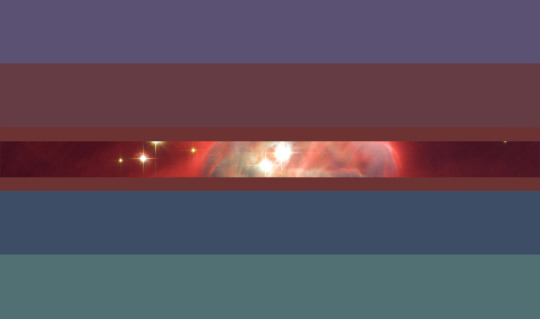
✧。:*▹ Conenebulaic

✧ Conenebulaic is a SPAN nebulaic gender related to the Cone nebula, or NGC 2264 in the constellation Monoceros. It may feel bestial and vast, like a looming creature devouring the cosmos.
✧ Pronouns can include:
cone/cone/cones/cones/coneself
neb/nebula/nebulas/nebulas/nebulaself
beast/beasts/beasts/beasts/beastself
✧ Day 11 pf @epikulupu event - Space

[ ID: A digital watercolor wash of reds, oranges, purples, and peaches on a dark indigo background. Words are in turquiose: “DNI: Racist, Prolife/anti-abortion, transmed, anti-BLM, homophobic, transphobic, racist, misogynistic, exclusionist, anti-MOGAI/xenos/neos, anti-anti, anti-decolonization, anti-lesboy/turigirl, anti-otherkin, TERF/radfem, believes ‘narc uhbuse’ is real.” End ID. ]
#Conenebulaic#ngc 2264#nebula#nebulaself#coneself#beastself#nebulaic#lgbtqia+#mogai haven#mogai coining#liom coining#coined by me#new term#new gender#new flag#nox's terms#nox's flags#SPAN#spangender#epikulupu event#day 11#space
46 notes
·
View notes
Link
Say hello to Anna, our newest host and the latest addition to the Astronomy Daily Team.
**Featured Topics:**
**SpaceX Crew-7's Triumphant Return:** Reflecting on the achievements of the international crew and their record-setting mission aboard the Endurance spacecraft.
**The Black Hole's Feast:** Diving into the tidal disruption event in galaxy NGC 3799, shedding light on the nature of supermassive black holes.
**AtLAST's Vision:** Exploring the potential of the proposed Atacama Large Aperture Submillimeter Telescope to unlock the universe's radio wave secrets.
**Nuclear Power on the Moon:** Discussing Roscosmos and CNSA's plans for a nuclear reactor on the moon to power the International Lunar Research Station.
**SLS Block 1B's Evolution:** Anticipating the enhanced capabilities of NASA's SLS Block 1B and its role in the Artemis program's expansion.
For a daily dose of the cosmos, visit astronomydaily.io and subscribe to our newsletter for the latest updates. Connect with us and share your thoughts; we're eager to hear from our community of star gazers. Remember, the mysteries of the universe await, and we're here to guide you through them.
#3799#black#commercial#crew#disruption#event#experiments#hole#international#microgravity#nasa#ngc#program#seven#space#spacewalks#spacex#station#supermassive#tidal
0 notes
Text
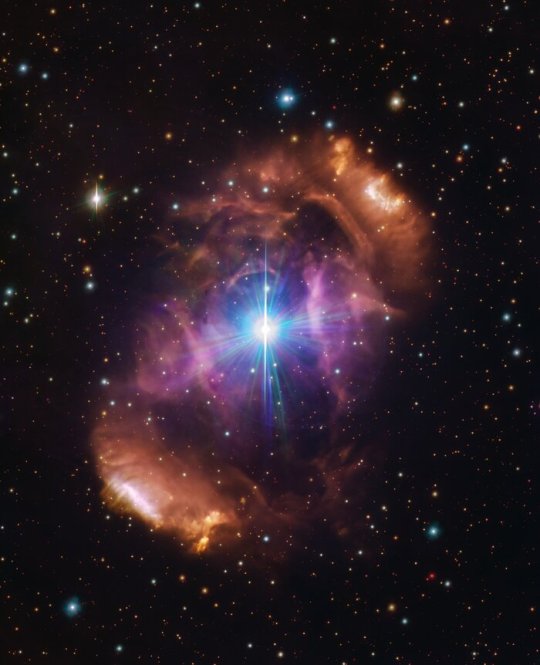
This image, taken with the VLT Survey Telescope hosted at ESO’s Paranal Observatory, shows the beautiful nebula NGC 6164/6165, also known as the Dragon’s Egg. The nebula is a cloud of gas and dust surrounding a pair of stars called HD 148937.
In a new study using ESO data, astronomers have shown that the two stars are unusually different from each other — one appears much younger and, unlike the other, is magnetic. Moreover, the nebula is significantly younger than either star at its heart, and is made up of gases normally found deep within a star and not on the outside. These clues together helped solve the mystery of the HD 148937 system — there were most likely three stars in the system until two of them clashed and merged, creating a new, larger and magnetic star. This violent event also created the spectacular nebula that now surrounds the remaining stars. Credit:
Credit: ESO
813 notes
·
View notes
Text
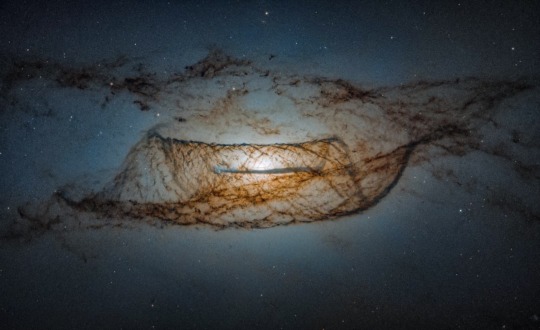
Hubble Just Released A New Photo Showcasing This Remarkably Strange Looking Lenticular Galaxy; NGC 4753
Featured in this new image from the NASA/ESA Hubble Space Telescope is a nearly edge-on view of the lenticular galaxy NGC 4753. These galaxies have an elliptical shape and ill-defined spiral arms.
This image is the object's sharpest view to date, showcasing Hubble's incredible resolving power and ability to reveal complex dust structures. NGC 4753 resides around 60 million light-years from Earth in the constellation Virgo and was first discovered by the astronomer William Herschel in 1784. It is a member of the NGC 4753 Group of galaxies within the Virgo II Cloud, which comprises roughly 100 galaxies and galaxy clusters.
This galaxy is believed to be the result of a galactic merger with a nearby dwarf galaxy roughly 1.3 billion years ago. Its distinct dust lanes around its nucleus are believed to have been accreted from this merger event.
It is now believed that most of the mass in the galaxy lies in a slightly flattened spherical halo of dark matter. Dark matter is a form of matter that cannot currently be observed directly, but is thought to comprise about 85% of all matter in the Universe. It is referred to as 'dark' because it does not appear to interact with the electromagnetic field, and therefore does not seem to emit, reflect or refract light.
This object is also of scientific interest to test different theories of formation of lenticular galaxies, given its low-density environment and complex structure. Furthermore, this galaxy has been host to two known Type la supernova.
These types of supernovae are extremely important as they are all caused by exploding white dwarfs which have companion stars, and always peak at the same brightness ~ 5 billion times brighter than the Sun. Knowing the true brightness of these events, and comparing this with their apparent brightness, gives astronomers a unique chance to measure distances in the Universe.
#galaxies#galaxy#nasaastronaut#nasa science#nasa#nasa picture of the day#nasawebb#space exploration#outer space#space#science#james webb space technology#space shuttle#astronomy#astronomers#universe#astrophotography#nasa photos#astrophysics#hubble space telescope#planetary science#science facts#planetary nebula#space science#space photography#the universe#our universe#solar system#cosmos#i love astronomy
65 notes
·
View notes
Text
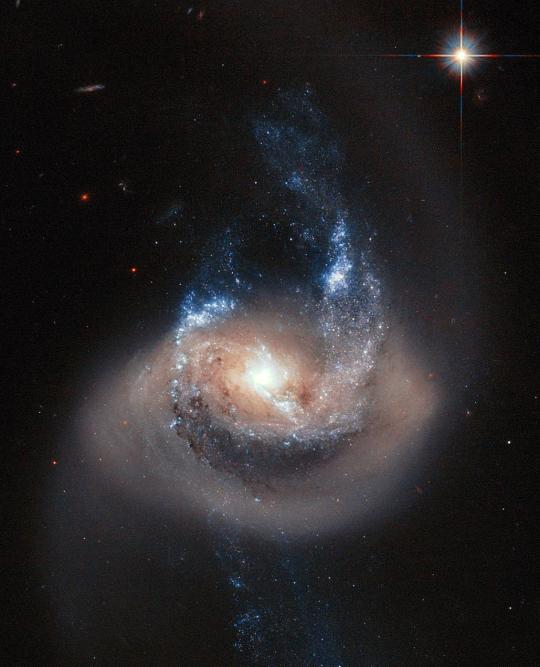
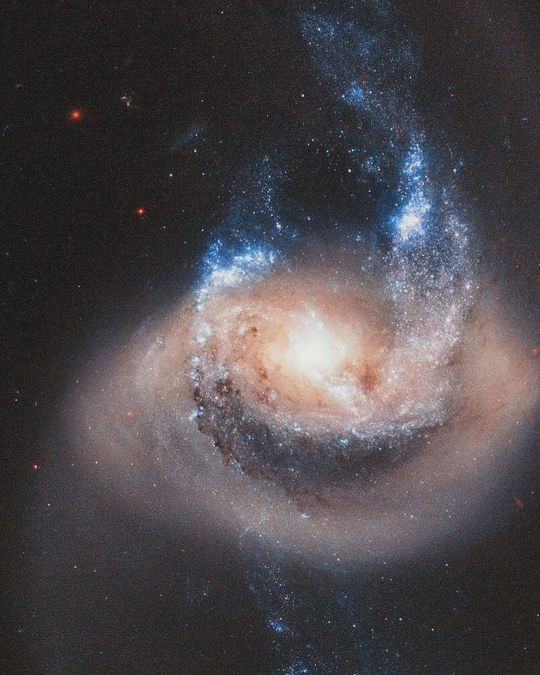

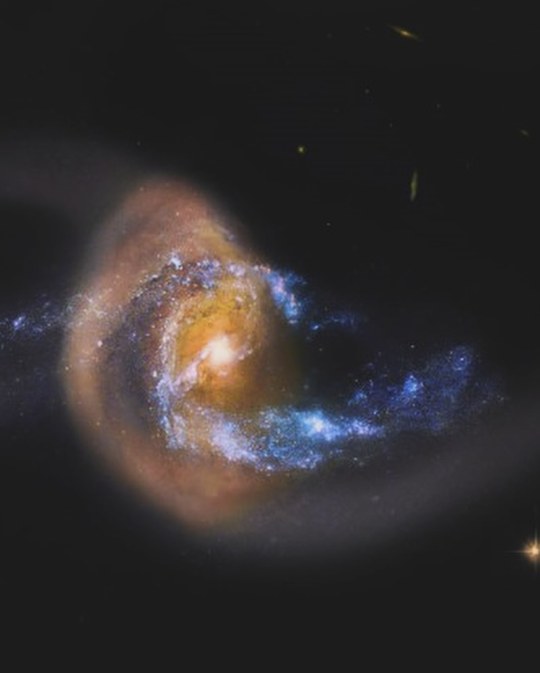
THE MASTER OF THE UNIVERSE CRUSHES ALL -- WHEN TWO GALAXIES COLLIDE.
PIC(S) INFO: Spotlight on a Hubble image of NGC 7714, a spiral galaxy 100 million light-years from Earth. 🔭+📸: ESA (European Space Agency) & NASA.
MINI-OVERVIEW: "NGC 7714 is a spiral galaxy 100 million light-years from Earth — a relatively close neighbour in cosmic terms.
The galaxy has witnessed some violent and dramatic events in its recent past. Tell-tale signs of this brutality can be seen in NGC 7714's strangely shaped arms, and in the smoky golden haze that stretches out from the galactic centre — caused by an ongoing merger with its smaller galactic companion NGC 7715..."
-- ESA HUBBLE, "Hubble image of NGC 7714," first published in 2015
Acknowledgement: A. Gal-Yam (Weizmann Institute of Science)
Sources: https://esahubble.org/images/heic1503a, Picuki, & X (formerly Twitter).
#NGC 7714#NGC 7715#Galaxies#Spiral Galaxy#Galaxy#Deep Space#Space is Deep#Colliding Galaxies#Galaxy Collision#Hubble Telescope#Outer Space#Hubble Space Telescope#Space Telescope#Astrophotography#Hubble#Cosmic Forces#Astronomy
23 notes
·
View notes
Text

New SpaceTime out Monday....
SpaceTime 20240401 Series 27 Episode 40
Strong magnetic fields at the edge of Milky Way’s supermassive black hole
A new image from the Event Horizon Telescope has uncovered strong organised magnetic fields spiralling around the edge of Sagittarius A* the supermassive black hole at the centre of our Milky Way Galaxy.







New studies show blue supergiant stars can be formed through stellar mergers
A new study has found that some of the brightest, hottest, and most luminous stars in the universe are created by the merger of two smaller stars.

Peering Into the Tendrils of a distant galaxy
The Webb space telescope has provided astronomers with a new view of a spectacular star forming region called NGC-604 deep inside the Triangulum Galaxy M-33.
Moscow sends a new crew to the International Space Station
A Russian Soyuz capsule has safely docked to the International Space Station as it flew 420 kilometres above the planet.









The Science Report
How spending less time sitting could help reduce blood pressure in people over 60.
Scientists map the genome of sugarcane.
It’s true, today’s music really isn’t as good as that back in the olden days.
Skeptics guide to why people believe in astrology
SpaceTime covers the latest news in astronomy & space sciences.
The show is available every Monday, Wednesday and Friday through Apple Podcasts (itunes), Stitcher, Google Podcast, Pocketcasts, SoundCloud, Bitez.com, YouTube, your favourite podcast download provider, and from www.spacetimewithstuartgary.com
SpaceTime is also broadcast through the National Science Foundation on Science Zone Radio and on both i-heart Radio and Tune-In Radio.
SpaceTime daily news blog: http://spacetimewithstuartgary.tumblr.com/
SpaceTime facebook: www.facebook.com/spacetimewithstuartgary
SpaceTime Instagram @spacetimewithstuartgary
SpaceTime twitter feed @stuartgary
SpaceTime YouTube: @SpaceTimewithStuartGary
SpaceTime -- A brief history
SpaceTime is Australia’s most popular and respected astronomy and space science news program – averaging over two million downloads every year. We’re also number five in the United States. The show reports on the latest stories and discoveries making news in astronomy, space flight, and science. SpaceTime features weekly interviews with leading Australian scientists about their research. The show began life in 1995 as ‘StarStuff’ on the Australian Broadcasting Corporation’s (ABC) NewsRadio network. Award winning investigative reporter Stuart Gary created the program during more than fifteen years as NewsRadio’s evening anchor and Science Editor. Gary’s always loved science. He studied astronomy at university and was invited to undertake a PHD in astrophysics, but instead focused on his career in journalism and radio broadcasting. He worked as an announcer and music DJ in commercial radio, before becoming a journalist and eventually joining ABC News and Current Affairs. Later, Gary became part of the team that set up ABC NewsRadio and was one of its first presenters. When asked to put his science background to use, Gary developed StarStuff which he wrote, produced and hosted, consistently achieving 9 per cent of the national Australian radio audience based on the ABC’s Nielsen ratings survey figures for the five major Australian metro markets: Sydney, Melbourne, Brisbane, Adelaide, and Perth. The StarStuff podcast was published on line by ABC Science -- achieving over 1.3 million downloads annually. However, after some 20 years, the show finally wrapped up in December 2015 following ABC funding cuts, and a redirection of available finances to increase sports and horse racing coverage. Rather than continue with the ABC, Gary resigned so that he could keep the show going independently. StarStuff was rebranded as “SpaceTime”, with the first episode being broadcast in February 2016. Over the years, SpaceTime has grown, more than doubling its former ABC audience numbers and expanding to include new segments such as the Science Report -- which provides a wrap of general science news, weekly skeptical science features, special reports looking at the latest computer and technology news, and Skywatch – which provides a monthly guide to the night skies. The show is published three times weekly (every Monday, Wednesday and Friday) and available from the United States National Science Foundation on Science Zone Radio, and through both i-heart Radio and Tune-In Radio.
#science#space#astronomy#physics#news#nasa#esa#astrophysics#spacetimewithstuartgary#starstuff#spacetime
15 notes
·
View notes
Photo
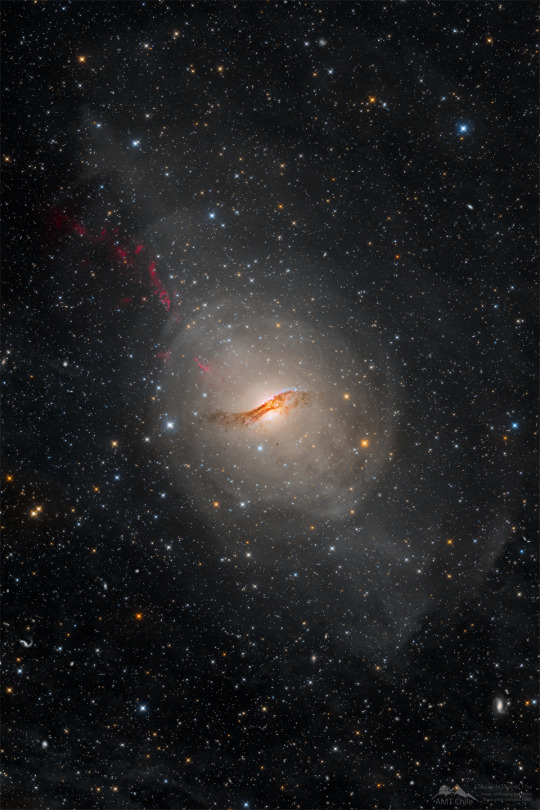
2023 May 3
Centaurus A: A Peculiar Island of Stars
Image Credit & Copyright: Marco Lorenzi, Angus Lau & Tommy Tse; Text: Natalia Lewandowska (SUNY Oswego)
Explanation: Galaxies are fascinating. In galaxies, gravity alone holds together massive collections of stars, dust, interstellar gas, stellar remnants and dark matter. Pictured is NGC 5128, better known as Centaurus A. Cen A is the fifth brightest galaxy on the sky and is located at a distance of about 12 million light years from Earth. The warped shape of Cen A is the result of a merger between an elliptical and a spiral galaxy. Its active galactic nucleus harbors a supermassive black hole that is about 55 million times more massive than our Sun. This central black hole ejects a fast jet visible in both radio and X-ray light. Filaments of the jet are visible in red in the upper left. New observations by the Event Horizon Telescope have revealed a brightening of the jet only towards its edges -- but for reasons that are currently unknown and an active topic of research.
∞ Source: apod.nasa.gov/apod/ap230503.html
105 notes
·
View notes
Text
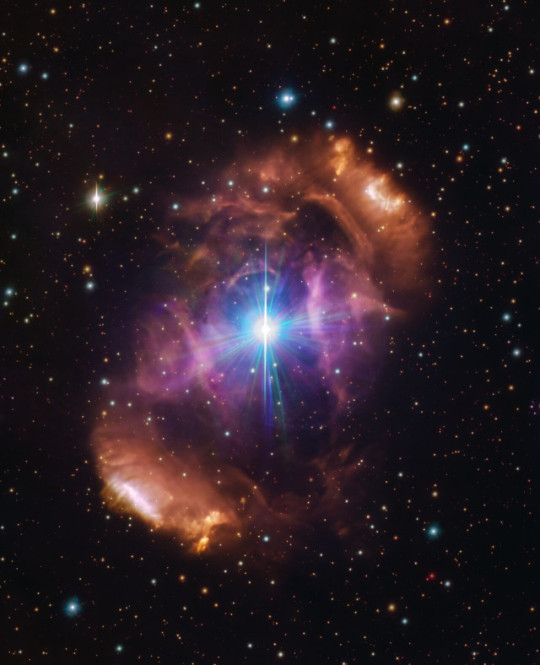
An article published in the journal "Science" reports a study on the HD 148937 system, a binary system surrounded by a double nebula known as NGC 6164/6165. A team of researchers used the PIONIER and GRAVITY instruments mounted on ESO's VLT Interferometer (VLTI) in Chile and archival data from the FEROS instrument at the La Silla Observatory, also an ESO's telescope in Chile, to collect the data necessary to conclude that it was originally at least a triple system and at some point two of the stars merged. It was a violent event that created the cloud of materials around the system.
12 notes
·
View notes
Text

𝑺𝒕𝒂𝒓 𝑭𝒐𝒓𝒎𝒂𝒕𝒊𝒐𝒏 𝑵𝒆𝒃𝒖𝒍𝒂 𝑵𝑮𝑪 3603
Like a 4th of July fireworks display, a young, glittering collection of stars looks like an aerial burst. The cluster is surrounded by clouds of interstellar gas and dust—the raw material for new star formation. The nebula, located 20,000 light-years away in the constellation Carina, contains a central cluster of huge, hot stars, called NGC 3603.
This environment is not as peaceful as it looks. Ultraviolet radiation and violent stellar winds have blown out an enormous cavity in the gas and dust enveloping the cluster, providing an unobstructed view of the cluster.
Most of the stars in the cluster were born around the same time but differ in size, mass, temperature, and colour. The course of a star's life is determined by its mass, so a cluster of a given age will contain stars in various stages of their lives, giving an opportunity for detailed analyses of stellar life cycles. NGC 3603 also contains some of the most massive stars known. These huge stars live fast and die young, burning through their hydrogen fuel quickly and ultimately ending their lives in supernova explosions.
Star clusters like NGC 3603 provide important clues to understanding the origin of massive star formation in the early, distant Universe. Astronomers also use massive clusters to study distant starbursts that occur when galaxies collide, igniting a flurry of star formation. The proximity of NGC 3603 makes it an excellent lab for studying such distant and momentous events.
This Hubble Space Telescope image was captured in August 2009 and December 2009 with the Wide Field Camera 3 in both visible and infrared light, which trace the glow of sulfur, hydrogen, and iron.
297 notes
·
View notes
Text
My presentation at the "Stars" event
A few weeks ago, I attended the "Stars" event, which showcases the talents and research of students in a wide variety of areas.
In my presentation, I spoke about my colorized photos of the Crab and Iris Nebula with my partner Andrew Berlo, who spoke about his photos separately, he took colorized photos of Saturn and the Flame Nebula, which he did a fantastic job on, which you can see labelled below.
(Flame Nebula, colorized and edited by Andrew Berlo)
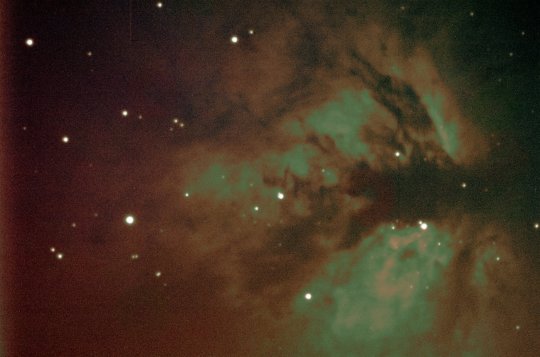
(Saturn, colorized and edited by Andrew Berlo)

In our poster, we compared our final results of the Crab Nebula photos, and the following is what we said about our final results.
"For my image of the Crab Nebula, I edited to make the Crab Nebula appear greenish in color, while also having blue, green, and red appear throughout the surrounding stars. The Crab Nebula is located about 6,500 light years from Earth and is a supernova remnant located in the constellation Taurus." (Andrew Berlo)

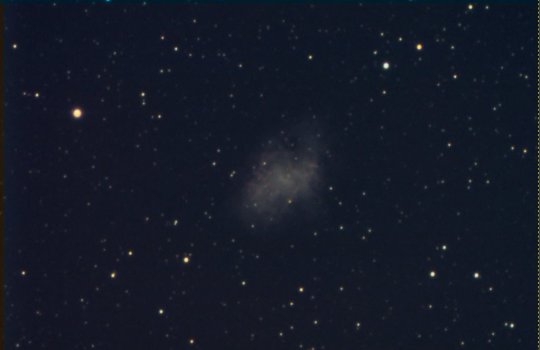
"For my image of the 'Crab Nebula', I had made several attempts to get a clear shot of this image, but finally was able to get one once I applied several settings and tools. Including the 'Curves', 'Levels' and 'Hard Light' filter to the 'Luminance' layer, which allows everything in the image to be much clearer and brighter.
My result ended up showing the nebula as being more of a cloud, unlike Andrew's. Which shows more of the interior of the nebula.
This image was the result of 3 other attempts that resulted in an either an overexposed or pixelated mess." (Cameron Williams)
I also spoke in detail about my final product of the Iris Nebula, in the description, I went in-depth on the details of how I edited it, and how I got the final result. And here is what I said in the poster;

"In this image of the Iris Nebula, I used the editing software 'GIMP' to manipulate the three main layers of this image, those are the Blue, Green, and Red layers.
Located 1,300 light years away, the Iris Nebula appears to be predominantly Blue. However, in my editing process, although it did come out a bright blue color, it was not very clear. And the clearest I could get it was when I increases the red color's intensity, which made it appear to be a purple hue to it.
In fact, I had to make a second 'Luminance' layer and add a "Hard Light" filter for the Nebula to be picked up on the screen."
Overall, I enjoyed the event, I saw other people's presentations about the same thing (Astrophotography), but also other topics, such as "Adoption", "Housing Costs", etc.
SOURCES:
References
“The Crab Nebula seen in New Light by NASA’s Webb”, NASA Observatory, 30 October 2023, The Crab Nebula Seen in New Light by NASA’s Webb – NASA
“Saturn”, NASA, February 2024, Saturn - NASA Science
“Flame Nebula”, Wikipedia, 20 March 2024, Flame Nebula -
Wikipedia
"NGC 7023", Astro Backyard, https://astrobackyard.com/iris-nebula/
"The Iris Nebula", Wikipedia, July 25 2023: https://en.wikipedia.org/wiki/Iris_Nebula
#astrophotography#space#stars#lunar#outer space#nebula#thegreatunknown#planets#astronomy#astro observations
8 notes
·
View notes
Text
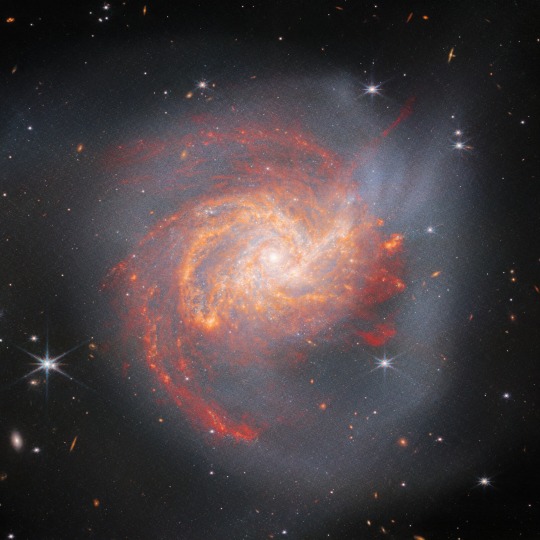
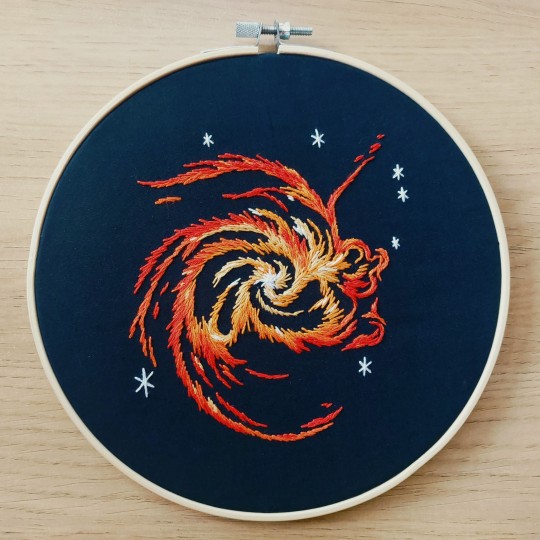
Clash of the Titans – NGC 3256
A galaxy 120 million light years away in the constellation Vela, as imaged by the James Webb telescope in IR earlier this month (and later rendered in embroidery by yours truly). NGC 3256 formed from the collision of two spiral galaxies half a billion years ago. At its core are two nuclei, which will eventally coalesce as the merger continues. It has two prominent spiral arms and a bright halo of stars which have been distorted into tidal tails by galactic tides.
26 notes
·
View notes
Note
can this be all ana songs event please and thank you… and tbh choosing numbers was very hard wish you made a podcast episode talking about all of them… but for me 6, 17, 23, 26 and 30 🫶🏻💝🎶
anything for you my sweetest darling teo also i WISH like we need to sit down over coffee and actually both of us go through the whole list to one another. deal? deal! anyway let’s GO i’ll try my hardest not to be too insane about this.
6: A song that makes you want to dance
literally first song that came to mind is get up by ciara and the second one was SO honestly low by flo rida what can i say the step up movies moved me. i was so sure i’d start a dancing career like if you know how taemin said while he was a trainee he’d dance in the street while going home from school just to spend every second practicing well. could’ve been me if that motivation lasted for longer than 30 mins after each movie
17: A song that would sing a duet with on karaoke
teo ik the question doesn’t specify w whom but you and i need to do (listen to me carefully now please see my vision): promiscuous by nelly furtado & timbaland (celibate priest version) please it would literally the best thing ever. we could do a twin moment like bey & shakira in beautiful liar too omg my brain. WHEW
23: A song that you think everybody should listen to
okay well without being goofy at all like no-brainer freedom by beyoncé. gives me chills and moves me to tears every time like it’s the first. incredibly powerful and so moving just. well. me talking about it is redundant i truly think everybody should listen to it
26: A song that makes you want to fall in love
lest i do another bey song (i got this number multiple times actually so i’ll do that in another ask hehe stay tuned!) but for SURE love from NGC 7318 by tanerélle (actually multiple songs by her make me feel this way) she’s so insanely good at translating emotion. Especially with ‘NGC 7318’ being a pair of colliding galaxies several hundreds of lightyears away from earth and with the lesbian theme oh it is just incredible. i don’t even need to be in love to feel in love when i listen to this song
30: A song that reminds you of yourself
i could go for so many fun ones (like i did the first time i answered this) and you did say this is an all ana songs instead of shinee event but oh i just have to say elevator by jonghyun. if i get into it i will absolutely start crying and i don’t wanna do that (and it’s absolutely an if i loved you less i might be able to talk about it more type of thing - a problem that i often have smh) but anyway i’ve been vocal about this being my soul song ever since it first came out so let me talk less for once and have a quote do the work for me this time: “he is half of my soul, as the poets say”
#this was SO emotional and fun and actually such an all around gorgeous experience for me teo you really chose such great ones tysm 🥹#i hope you like it! our karaoke duet would be so good i surprised my own self w that actually#love uuuuuu 🫶🏻#ask game
14 notes
·
View notes
Text
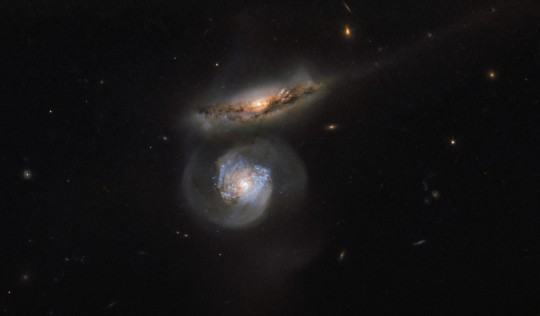
"Megamaser" Galaxy
"Feast your eyes on Hubble's Megamaser galaxy! Phenomena across the Universe emit radiation spanning the entire electromagnetic spectrum — from high-energy gamma rays, which stream out from the most energetic events in the cosmos, to lower-energy microwaves and radio waves. Microwaves, the very same radiation that can heat up your dinner, are produced by a multitude of astrophysical sources, including strong emitters known as masers (microwave lasers), even stronger emitters with the somewhat villainous name of megamasers and the centers of some galaxies. Especially intense and luminous galactic centers are known as active galactic nuclei. They are in turn thought to be driven by the presence of supermassive black holes, which drag surrounding material inwards and spit out bright jets and radiation as they do so. The two galaxies shown here, imaged by the NASA/ESA Hubble Space Telescope, are named MCG+01-38-004 (the upper, red-tinted one) and MCG+01-38-005 (the lower, blue-tinted one). MCG+01-38-005 (also known as NGC 5765B) is a special kind of megamaser; the galaxy’s active galactic nucleus pumps out huge amounts of energy, which stimulates clouds of surrounding water. Water’s constituent atoms of hydrogen and oxygen are able to absorb some of this energy and re-emit it at specific wavelengths, one of which falls within the microwave regime, invisible to Hubble but detectable by microwave telescopes. MCG+01-38-005 is thus known as a water megamaser! Astronomers can use such objects to probe the fundamental properties of the Universe. The microwave emissions from MCG+01-38-005 were used to calculate a refined value for the Hubble constant, a measure of how fast the Universe is expanding. This constant is named after the astronomer whose observations were responsible for the discovery of the expanding Universe and after whom the Hubble Space Telescope was named, Edwin Hubble."
Image and information from NASA
41 notes
·
View notes
Text
Cygnus X-1
Cygnus X-1 (Adding Aquarian Insight ~ 5 Feb 2021, Philip Sedgwick)
As Earth and the creatures upon it currently absorb an abundance of Aquarian energy from above, this would be a good time to personalize and extend the reach of the sign’s meaning. Such amplification can be found as objects in our solar system are enhanced as they transit an array of black holes that lie beyond our galaxy.
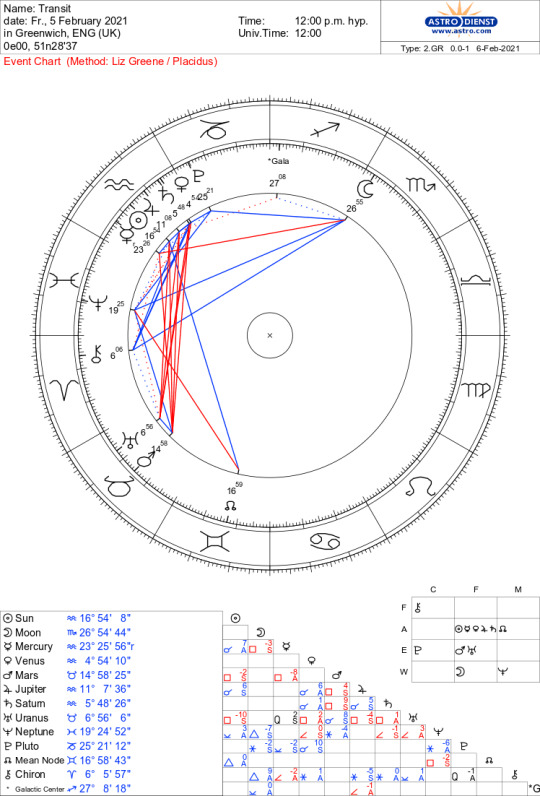
Following are slightly more than a handful of the black holes confirmed in Aquarius and their approximate correct degree and minute for 2021.
Before diving over the event horizon of each of the black holes and into its singularity, let’s address two technical questions that may divert attention from the delineations.
Where was the black hole when you were born? Roughly, you’d need to counter precess the positions listed below by eight minutes of an arc for every decade (or 50.26 seconds per year). So if you were born thirty-five years ago that would be 28 minutes earlier that posits below. Actually given these points advance one degree every 72 years and considering their immense gravitation influence, you can actually overlook exactitude as use a “close enough for government work” attitude to applying them.
How much gravitational influence do these things wallop us with? What’s the orb for a planet to these galactic enigmas? Give them four degrees either side of partile, plus or minus.
Why do we care about these black holes? Two of the following, Cygnus X-1 and Cygnus X-3 were among the first black holes realized. Cygnus X-1 was the first theorized, hinting at what it was when x-ray detection became a thing in astrophysics a half century ago. Actually, astroarchaeologists believe that cuneiforms painted by the Sumerians thousands of years ago depicted Cygnus X-1 and referred to it as overseeing the “netherworld.” That’s interesting.
Further, Cygnus X-1 was used to confirm event horizons - the edge of black holes - and shifted black hole theory into more of consensus reality.
Some of the black holes below have their periods (P) noted. A few have the pulse frequency of x-ray emanations (p). NOTE: d = days; s = seconds. The pulse establishes the duration of time required for the exposure to an advanced idea or concept to grasp its magnitude. The period represents the time required to completely assimilate any mental, emotional or psychic realization into a useful state for the psyche. You know, how long do you need to wrap around it?
So there they are with their awkward names and a bullet point to process as the planets transit:
04 AQ 25, NGC 7022
Establish your own early warning system. Notify yourself promptly of any indication of your withdrawal from life. Do not withdraw. Step back and process, then re-engage.
10 AQ 46, V* QZ Vul
Learn to be so present you cannot be seen. If you want invisibility and to remain anonymous, go do your thing with making a fuss about what you’re doing. What’s important is that you receive insights and deal with them promptly.
11 AQ 27, 4U 1954+31 P = 5.09 hrs
Changing pace and course as a matter of course secures constancy and sure footedness. It’s not about changing your mind as a matter of course, it’s about evolving as you process new and extended insights.
12 AQ 42, 3U 0115-73, P = 3.89d, 16.66 d, p = 0.714s
If you make a practice to go out of body, you miss the benefits of existing on the material plane.
14 AQ 03, 3U 1956+35, Cyg X-1, P = 5.6d
You are totally unique. So is everyone else. With connections to this black hole in your chart you possess an innate ability to forecast what lies over the next horizon. Barometric predictive consciousness and trend-setting create significance to ones efforts, not to be confused with being an influencer. An influencer latches onto something someone else has done and hypes it into popularity. A barometric trendsetter perceives a need in the near future and conjures the concept or product that satisfies that need and creates it, or gathers the team to do so.
When transiting, innovations fill the airwaves and become whispers in the wind.
17 AQ 48, 3C 405.0
Some say if it weren’t for the fringe, the flag would unravel. The point where the fringe merges with the flag equals participation in the collective. While fringe folks believe in the essentially of their cantankerousness, other perceive rabble-rousing and destruction. Work to be part of the solution, not the problem.
21 AQ 09, GS 2023+338, P = 6.4717d
Promoting individuality and acknowledging personal distinctiveness inspires collective cooperation by those promoted.
28 AQ 56 3U 2030+40 Cyg X-3, p = 17,280s (4.8h)
If nothing brilliant is ever done, you will not be seen for your light you can shed. Others will not be able to recognize the brilliance, appreciate your merit or include you in life’s festivities should you not reach as far as you can to gather your insights and ground them in reality.
So, there’s a bit of a tiptoe through the tantalizing aspirations of black holes to add to the “out there” innate skills of Aquarius. Over the next weeks everyone is subject to receiving blasts of amazing, constructive insights hell bent on stirring progress and evolution into the mix of human consciousness.
If you’d like to support these inspirations with a greater understanding of these ongoing stimulations, how about clicking the links below to order a Galactic Report (perfect for enhancing Aquarian influences), schedule a consultation, ask a question or two dive into the Galactic Trilogy, which is rich in black hole delineation.
This past week my short film, ZAP! achieved FINALIST status in the January 2021, Luleå Film Festival (Sweden) selections. The same day I received word that ZAP! is an Official Selection in the Front Range Film Festival (Colorado) and will screen virutally on 20 February. If anyone is interested in viewing the film here’s the ticketing link for the Front Range Film Festival. My eye is on my filmmaker in-box as there are more announcements to be made. It’s an arduous thing, these film selections… your film is competing with thousands of high-quality films from all over the world for but a small number of selection slots and within the skews to festival selection criterion caused by the pandemic. More to come!
1 note
·
View note
Text
Events 4.29
801 – An earthquake in the Central Apennines hits Rome and Spoleto, damaging the basilica of San Paolo Fuori le Mura.
1091 – Battle of Levounion: The Pechenegs are defeated by Byzantine Emperor Alexios I Komnenos.
1386 – Battle of the Vikhra River: The Principality of Smolensk is defeated by the Grand Duchy of Lithuania and becomes its vassal.
1429 – Joan of Arc arrives to relieve the Siege of Orléans.
1483 – Gran Canaria, the main island of the Canary Islands, is conquered by the Kingdom of Castile.
1521 – Swedish War of Liberation: Swedish troops defeat a Danish force in the Battle of Västerås.
1760 – French forces commence the siege of Quebec which is held by the British.
1770 – James Cook arrives in Australia at Botany Bay, which he names.
1781 – American Revolutionary War: British and French ships clash in the Battle of Fort Royal off the coast of Martinique.
1826 – The galaxy Centaurus A or NGC 5128 is discovered by James Dunlop.
1861 – Maryland in the American Civil War: Maryland's House of Delegates votes not to secede from the Union.
1862 – American Civil War: The Capture of New Orleans by Union forces under David Farragut.
1864 – Theta Xi fraternity is founded at Rensselaer Polytechnic Institute, the only fraternity to be founded during the American Civil War.
1903 – A landslide kills 70 people in Frank, in the District of Alberta, Canada.
1910 – The Parliament of the United Kingdom passes the People's Budget, the first budget in British history with the expressed intent of redistributing wealth among the British public.
1911 – Tsinghua University, one of mainland China's leading universities, is founded.
1916 – World War I: The UK's 6th Indian Division surrenders to Ottoman Forces at the Siege of Kut in one of the largest surrenders of British forces up to that point.
1916 – Easter Rising: After six days of fighting, Irish rebel leaders surrender to British forces in Dublin, bringing the Easter Rising to an end.
1944 – World War II: New Zealand-born SOE agent Nancy Wake, a leading figure in the French Resistance and the Gestapo's most wanted person, parachutes back into France to be a liaison between London and the local maquis group.
1945 – World War II: The Surrender of Caserta is signed by the commander of German forces in Italy.
1945 – World War II: Airdrops of food begin over German-occupied regions of the Netherlands.
1945 – World War II: HMS Goodall (K479) is torpedoed by U-286 outside the Kola Inlet, becoming the last Royal Navy ship to be sunk in the European theatre of World War II.
1945 – World War II: Adolf Hitler marries his longtime partner Eva Braun in a Berlin bunker and designates Admiral Karl Dönitz as his successor.
1945 – Dachau concentration camp is liberated by United States troops.
1945 – The Italian commune of Fornovo di Taro is liberated from German forces by Brazilian forces.
1946 – The International Military Tribunal for the Far East convenes and indicts former Prime Minister of Japan Hideki Tojo and 28 former Japanese leaders for war crimes.
1951 – Tibetan delegates arrive in Beijing and sign a Seventeen Point Agreement for Chinese sovereignty and Tibetan autonomy.
1952 – Pan Am Flight 202 crashes into the Amazon basin near Carolina, Maranhão, Brazil, killing 50 people.
1953 – The first U.S. experimental 3D television broadcast shows an episode of Space Patrol on Los Angeles ABC affiliate KECA-TV.
1965 – Pakistan's Space and Upper Atmosphere Research Commission (SUPARCO) successfully launches its seventh rocket in its Rehber series.
1967 – After refusing induction into the United States Army the previous day, Muhammad Ali is stripped of his boxing title.
1968 – The controversial musical Hair, a product of the hippie counter-culture and sexual revolution of the 1960s, opens at the Biltmore Theatre on Broadway, with some of its songs becoming anthems of the anti-Vietnam War movement.
1970 – Vietnam War: United States and South Vietnamese forces invade Cambodia to hunt Viet Cong.
1974 – Watergate scandal: United States President Richard Nixon announces the release of edited transcripts of White House tape recordings relating to the scandal.
1975 – Vietnam War: Operation Frequent Wind: The U.S. begins to evacuate U.S. citizens from Saigon before an expected North Vietnamese takeover. U.S. involvement in the war comes to an end.
1975 – Vietnam War: The North Vietnamese army completes its capture of all parts of South Vietnam-held Trường Sa Islands.
1986 – A fire at the Central library of the Los Angeles Public Library damages or destroys 400,000 books and other items.
1986 – The United States Navy aircraft carrier USS Enterprise becomes the first nuclear-powered aircraft carrier to transit the Suez Canal, navigating from the Red Sea to the Mediterranean Sea to relieve the USS Coral Sea.
1986 – Chernobyl disaster: American and European spy satellites capture the ruins of the No. 4 reactor at the Chernobyl Power Plant.
1991 – A cyclone strikes the Chittagong district of southeastern Bangladesh with winds of around 155 miles per hour (249 km/h), killing at least 138,000 people and leaving as many as ten million homeless.
1991 – The 7.0 Mw Racha earthquake affects Georgia with a maximum MSK intensity of IX (Destructive), killing 270 people.
1992 – Riots in Los Angeles, following the acquittal of police officers charged with excessive force in the beating of Rodney King. Over the next three days 63 people are killed and hundreds of buildings are destroyed.
1997 – The Chemical Weapons Convention of 1993 enters into force, outlawing the production, stockpiling and use of chemical weapons by its signatories.
2004 – The final Oldsmobile is built in Lansing, Michigan, ending 107 years of vehicle production.
2011 – The Wedding of Prince William and Catherine Middleton takes place at Westminster Abbey in London.
2013 – A powerful explosion occurs in an office building in Prague, believed to have been caused by natural gas, and injures 43 people.
2013 – National Airlines Flight 102, a Boeing 747-400 freighter aircraft, crashes during takeoff from Bagram Airfield in Parwan Province, Afghanistan, killing seven people.
2015 – A baseball game between the Baltimore Orioles and the Chicago White Sox sets the all-time low attendance mark for Major League Baseball. Zero fans were in attendance for the game, as the stadium was officially closed to the public due to the 2015 Baltimore protests.
1 note
·
View note